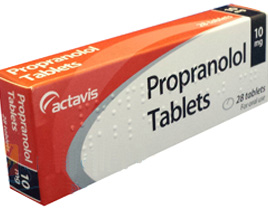Propranolol Overview Details
Propranolol is a non-selective beta-adrenergic receptor blocking agent. It has applications in managing a variety of cardiovascular conditions. Unlike selective beta-blockers, it affects beta-1 and beta-2 receptors, broadening its potential therapeutic use.
Pharmacological Properties Explained
Propranolol works by competitively binding to beta-adrenergic receptors. This binding reduces the effect of adrenergic stimulation, decreasing cardiac output and sympathetic nervous activity. It uniquely affects both heart rate by reducing beta-1 mediated chronotropic effect and vascular resistance by its action on beta-2 receptors.
Therapeutic Indications Summarized
Propranolol is used in treating hypertension, aiding in the reduction of elevated blood pressure. It is indicated for angina pectoris management, decreasing myocardial oxygen demand. Additionally, it is effective in arrhythmia control, migraine prophylaxis, and management of thyrotoxicosis symptoms.
Administration Guidelines Described
Propranolol is administered orally and should be taken consistently with or without food for steady absorption. Dosages are individualized based on condition severity and patient response. Immediate-release formulations are typically dosed multiple times daily, while extended-release versions allow once-daily dosing.
Metabolism and Excretion Explained
The liver metabolizes propranolol primarily by cytochrome P450 enzymes. Its metabolites are excreted via the kidneys. Propranolol has a variable first-pass metabolism, meaning initial dose absorption and processing may vary significantly among patients. Known genetic polymorphisms may influence metabolism rates, affecting plasma levels.
Drug Interaction Profile
Propranolol can interact with other medications, altering its effectiveness or increasing adverse effects. Caution is advised when combining it with other cardiovascular drugs like calcium channel blockers. Use with anti-arrhythmic agents can potentiate cardiac depressant activity.
Considerations in Special Populations
Dose adjustments may be necessary for elderly patients due to altered pharmacokinetics. Caution is required when prescribing to individuals with hepatic or renal impairment. Monitoring is recommended in diabetic patients, as it may mask hypoglycemia symptoms.
Chemical Composition Details
Propranolol is a synthetic compound with a chemical formula of C16H21NO2. Its structural features enable binding to adrenergic receptors. The medication is available in various salt forms, aiding in stability and bioavailability.
Half-Life and Duration Studied
Propranolol has an elimination half-life of approximately 3 to 6 hours, depending on individual metabolism. The duration of action varies; immediate-release forms last around 4 to 6 hours, whereas extended-release forms are designed for 24-hour efficacy. Regular administration ensures sustained therapeutic effects.
Physical and Storage Conditions
Propranolol tablets should be stored at room temperature, protected from light and moisture. Proper storage helps maintain the drug’s integrity and potency. Inadequate storage conditions can affect the efficacy and safety of the medication.
Scientific Research Evidence
Numerous clinical studies support propranolol’s efficacy in preventing migraine headaches. Research also highlights its role in reducing symptomatic manifestations of shaking in conditions such as essential tremor. Clinical trials demonstrate its comprehensive utility in managing diverse health conditions.
Analgesic Properties Insight
While not primarily an analgesic, propranolol can help manage pain indirectly by reducing symptoms related to anxiety and tachycardia. It may alleviate pain in conditions exacerbated by stress, reflecting its ancillary benefits beyond core indications.
Effects on Exercise Capacity
Propranolol may influence exercise tolerance due to its impact on heart rate and blood pressure. Beta-blockade can reduce maximal exercise capacity, highlighting the need for caution in athletes or physically active patients. Patient response varies, and dose adjustments may be necessary.
Beta-Blocker Comparisons Discussed
Propranolol differs from selective beta-blockers like metoprolol, which primarily affect beta-1 adrenergic receptors. Non-selective action gives propranolol broader applications but also increases potential for respiratory effects, due to beta-2 receptor involvement. Individual patient profiles guide the choice of beta-blocker usage.





Reviews
There are no reviews yet.